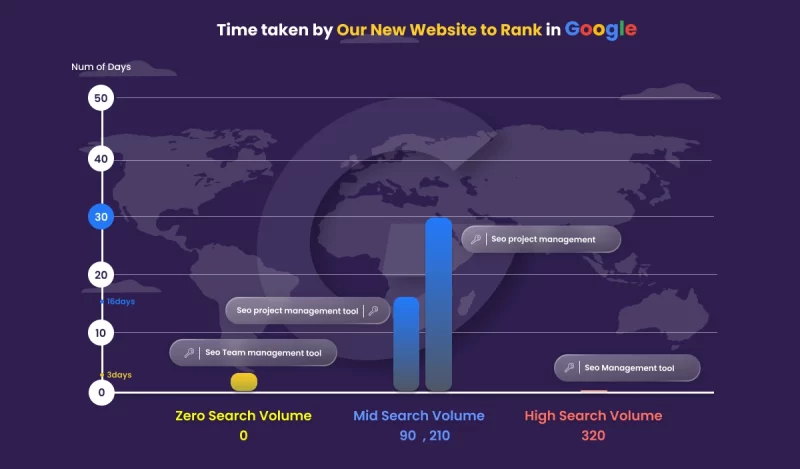
How Long Does It Take a New Website to Rank (Experimented with A Brand New Website)
Adam White
Posted on August 10, 2023
Alright, so you’ve just birthed a shiny new website into the digital world.
It’s like welcoming a new member to your family, right?
But now you’re probably wondering, ‘When’s the party, and where’s the crowd?’ When will your website start drawing in visitors and doing its magic?
Congratulations, you’re at that point where you’re asking, ‘What’s next?’
It’s a totally normal and exciting phase after creating a brand-new website for your business.
But tracking your rankings in the beginning can be frustrating.
Now, let’s get to the big question: When will your website bask in the glory of high visibility and a stream of eager visitors?
You’ve poured your heart, soul, money, and time into crafting this digital masterpiece, and it’s only fair to wonder when the world will see it in all its glory.
So, is there a straightforward answer to this legitimate question?
Well, not exactly. It’s not like flipping a switch, but here’s where we take the path of exploration.
To get a grip on this, we’re going on an adventure.
We’ll research, analyze, experiment, and maybe even do a little dance (kidding about the dance part) to figure out: How long does it take for a new website to rank on Google?
And if you’re starting a new business, you’ve put in weeks, maybe even months, to build a fantastic website.
It’s like having a beautiful storefront, but no one’s peeking inside. Why’s that? Why isn’t Google giving you the high-five you deserve?
The truth is, climbing to the top of the search engine rankings isn’t an overnight journey, especially if you’re a new or small business trying to make a name for yourself in the vast online world.
So, here’s the next big question: How long does it take to get your website to that coveted top spot on Google’s search results, below that mysterious black box?
According to our SEO sages and numerous sources, the average waiting time for a website to start ranking on Google is roughly three to four months.
Yep, you read that right! Going from ‘who’s this?’ to ‘top of the charts’ usually takes anywhere from 80 to 180 days.
The exact timing depends on how fierce the competition is in your industry and how popular the keywords you’re targeting are.
But here’s the exciting part: If you’ve got your website optimization game on point, this waiting period can shrink or stretch.
It’s all about the methods and magic you use to fine-tune your site.
Time to rank a new website to rank on Google – A live experiment
To get the inside scoop on which websites hit the high notes in Google’s rankings, let’s embark on a journey into the mysterious workings of search engines.
Ever wondered how Google decides who’s cool enough to make it to the top pages of its search results?
First things first, let’s clear up a common misconception: There’s no Harry Potter spell or secret formula that guarantees a top spot in Google’s rankings.
No one can predict exactly how long it takes for Google to give your website the thumbs-up to the front pages.
So, how much time does it take to climb the Google ladder and claim a spot at the top?
Brace yourself; it might be a waiting game that lasts a year or even longer. It all depends on how many SEO tricks you’ve got up your sleeve and how much effort you’ve put into optimizing your website.
With that said, here’s a golden nugget of wisdom: SEO is a marathon, not a sprint. So, be ready for the long haul; it takes a bit of time to get on Google’s radar.
Now, understanding how long it takes for a new website to rank isn’t just about curiosity; it’s also a practical move to calculate your ROI during this waiting period.
After all, did you know that around 33% of the clicks go to the websites on Google’s first page? That’s prime real estate right there!
And here’s a fun tidbit: The second result gets around 15% of the clicks, while the third one is like the bronze medalist with just 9%.
So, ranking on that first page is the ultimate goal.
So, let’s dive into the nitty-gritty of how long it takes for a fresh website to get cozy in Google’s rankings.
And to keep things real, we’re sharing a live experiment.
As a real-time example, we handpicked some keywords with different search volumes and strategically sprinkled them throughout the pages of our new website, SEOScrum.
It’s like crafting a recipe to make Google’s taste buds tingle.
And you know what we discovered? The time it takes for Google to warm up to a new website has a lot to do with the search volume of those keywords.
It’s the secret sauce in the SEO recipe.
So, hang tight, and let’s explore the details of how long it takes for a brand-new website to claim its spot on Google’s stage.
We’ll also uncover some key factors that affect ranking and how you can speed up this process.
Because who doesn’t want to get there faster, right?
How Much Time Does It Take to Rank on Google?
Can a fresh-out-of-the-oven website make its mark on Google? Well, the answer isn’t a straightforward yes or no.
It’s a bit like asking whether you can cook up a storm in the kitchen; it all depends on the recipe (or, in this case, your strategy).
Here’s the scoop: When it comes to ranking a brand-new website, there’s no one-size-fits-all answer.
It’s like trying to predict the weather in a place where it can be sunny one minute and rainy the next. In the world of SEO, it’s all about the niche you’re diving into, and there’s no fixed timeline.
On average, if you’re working your SEO magic consistently and have the right strategy in your back pocket, you can expect to see some significant results in about three to eight months.
It’s kind of like nurturing a plant; with care and attention, you’ll start to see it grow.
Now, let’s get into the nitty-gritty. SEO, or Search Engine Optimization, is the art of making your website look like a real rock star in the eyes of Google and other search engines.
It’s about aligning your site with what users are searching for so that Google says, ‘Hey, this is the place to be!’
But here’s the deal: Ranking is just one piece of the SEO puzzle.
The timing also depends on the industry you’re wading into, the keywords you’re targeting, and what the current search results look like for those keywords.
No worries if all this SEO talk sounds like alphabet soup to you.
If you’re new to this game, it’s totally okay! It’s like learning a new dance; you’ve got to start with the basics.
Now, let’s dive deeper into the magic trick that can speed up the process of ranking your website on Google. Who doesn’t want to get to the finish line a little faster, right?
Factors That Affect Google Rankings
Google’s algorithm relies on numerous factors to sift through and prioritize the top pages for each search query.
Every category is loaded with different indicators, all of which communicate to Google that your webpage has the sought-after information for its users.
It’s the web pages that deliver most of these indicators to Google that grab a spot on the first page.
Below are the various types of indicators Google pays attention to when deciding the position of online content:
1. The Value You Provide Through Your Content
The internet is a vast ocean teeming with information. When you search for a specific “keyword,” you might find thousands of results. This is why your content needs a unique twist, a fresh viewpoint that separates it from what’s already out there in the search results. Most importantly, it must offer real value.
In the digital world of 2023, it’s no longer about writing for search engines. It’s about providing meaningful and useful information based on the search intent. Google’s smart algorithms can quickly spot if your content is just a copy, and they appreciate fresh, unique contributions.
Read More: Know how fulfilling user search intent can gain you higher rankings
Here are a couple of strategies to help you create valuable content:
Draw from your personal experiences. Your journey and insights can add a unique flavor to your content, helping your readers see things from a different perspective. Sharing your experiences, both successes and failures can guide them on what to do and what to avoid.
Try using the Skyscraper Technique. This approach involves studying the top content that’s currently available on your chosen topic, and then creating something even better. Essentially, you’re building a “skyscraper” that stands taller than the rest.
Read More: What is skyscraper technique and how to execute it
Remember, the value your content provides is what makes it shine. So, keep your focus on adding value to the information already available on the internet. It might seem tough at first, but with practice and dedication, you’ll get the hang of it!
2. Try SILO in Your Content
In the SEO world, SILOing is like creating a family of similar content pieces. It’s a way to link together content that falls under the same category. This practice makes it easier for search engines to understand your content, and it can also boost your topical authority.
For a brand-new website, using the SILOing technique is like giving a map to search engines. It helps them quickly understand what your site is all about – its topic and niche.
Plus, SILOing isn’t just for the search engines – it’s for your users too! When you create a bunch of content about similar topics and link them together, it gives Google’s web crawlers a clear picture of your niche. This clarity can help improve your site’s rankings.
So, consider SILOing as a sort of stepping stone when starting your website. It’s not just beneficial in the early stages; it can also contribute to your site’s success in the long run. By organizing your content in this way, you’re building a solid foundation for your website’s future growth.
Know More: What is SILO, Pros & Cons of Using It
3. Know the Competition & their Weakness and Strengths
Before you dive into your own SEO campaign, it’s a good idea to learn about your competitors first. Pay close attention to what strategies have worked for them, as well as their weaknesses.
Look at the content that has landed them high on search results. Also, spot the content gaps – areas where you could provide additional value that they might have missed.
Understanding these aspects doesn’t just help you craft a solid content strategy. It also allows you to keep tabs on where your competitors are heading.
Another smart move is to create content in areas where your competitors aren’t ranking well. If their content on these topics isn’t hitting the mark, that might mean there’s room for improvement. This is a clear sign that Google is looking for more valuable content. By stepping in to fill the gap, you could give your own rankings a boost.
4. Target long-tail keywords
Usually, long-tail keywords, those specific phrases that people search for, are easier to rank high in search results. The people who use these keywords typically know exactly what they’re looking for – they want a specific answer.
There are various tools to identify long-tail keywords and even show you how tough it might be to rank for them.
When you’re first starting out, it can be tough to get your website to rank for general keywords, also known as “head terms.” That’s where long-tail keywords come into play. They can be an effective way to start building your presence in the search results.
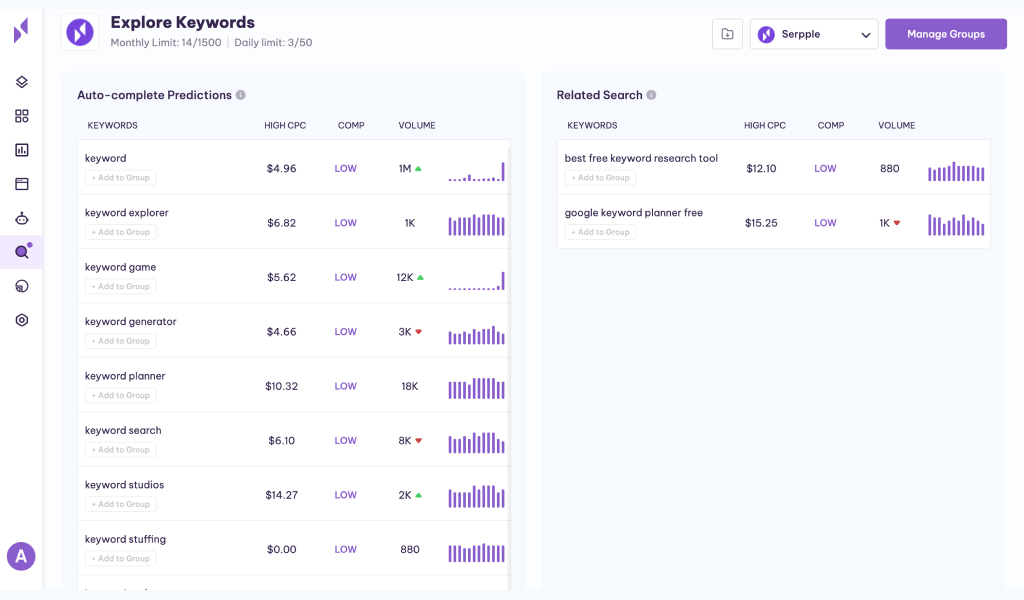
Exploring Long-tail keywords of the content in the website and its SERP metrics are deliberated in the image above. Remember, it’s not just about finding any long-tail keyword. The trick is to find ones that are relevant to your content and can help drive the right kind of traffic to your site. Over time, as you start to build authority and trust with search engines, you can begin to target more general, higher-competition keywords as well.
By balancing the use of long-tail and head-term keywords, you can create an effective SEO strategy that grows with your website.
5. Have An Internal Link Strategy in Place
Think of internal linking as the backbone of SEO. It’s like leaving breadcrumbs for web crawlers, guiding them from your existing pages to new ones.
What’s great about internal links is that you’re the boss of them. You have full control, unlike with external links that others might give you.
When you’re creating new content, keep in mind how it could link with the content you’ve already published. This way, your internal links are relevant and make sense.
Be careful though, if your content drifts away from your website’s main theme and you link it inappropriately, Google might not be happy. So, always ensure your content and links are in sync with your website’s overall theme.
And one more thing, don’t get carried away with internal link strategy. It’s not about linking everything you can. Use internal links where they will help make the content clearer to your users.
Keeping these tips in mind, along with the others we’ve discussed, will help you develop a well-rounded SEO strategy. As you grow and adapt, always remember to provide value, understand your competition, use long-tail keywords effectively, and maintain a healthy internal linking structure.
6. Over time keep refreshing your old content
Just like data that becomes outdated over time, your content can get old too. It’s a good idea to set up a timeline to spruce up your old content now and then.
Look for new keywords that are relevant to your content. If you spot new keywords that make sense for your content, try to incorporate them. One great way to do this is by using your search console. It can show you what new keywords are being associated with your content.
Google loves fresh, updated content. So, the more you keep your content current and peppered with up-to-date stats, the better your chances of impressing Google. And when Google’s happy, it’s more likely to reward you with higher rankings.
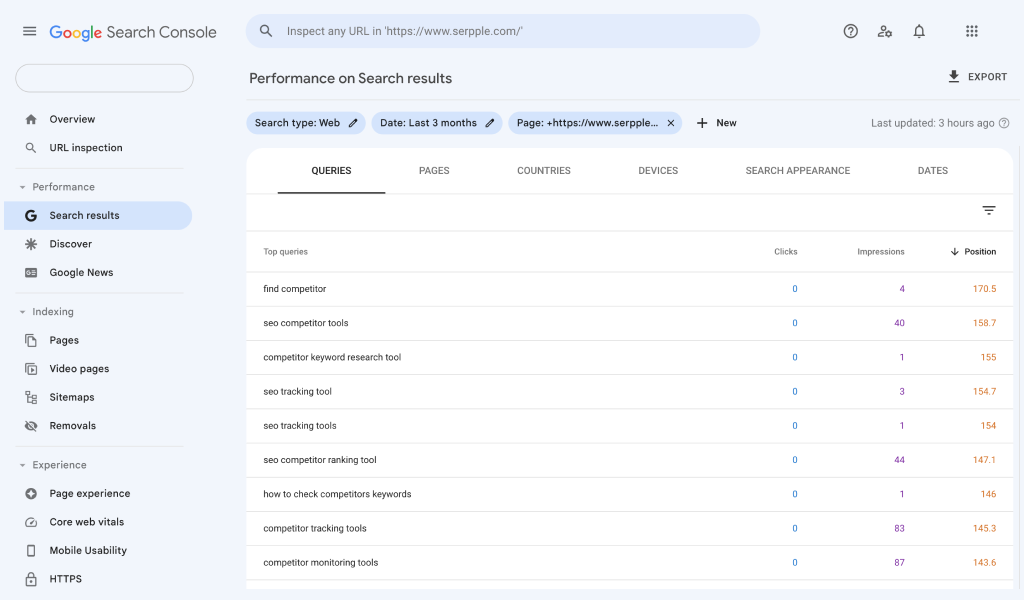
Remember, maintaining a website isn’t just about adding new content. It’s also about taking care of the content you’ve already published. By keeping your content fresh and relevant, you’re making sure your website continues to provide value for your readers and stays attractive to search engines.
Read More: Ways to refresh your content
7. Keywords in header tags
Using keywords in header tags is a bit like giving search engines a sneak peek at what your content is about. It’s a clever way to boost your content’s visibility in search results. After the title, the headers are the most prominent place to sprinkle in your keywords.
But why are headers so important? Think about how you read an article. You likely skim through it first, checking out the headings to see what grabs your interest. Search engines work in a similar way. They use headers to get a quick overview of your content.
The potential keywords for SEO techniques were imparted in the header tags shown in the search engine results illustrated.
By placing your keywords in the headers, you’re not only telling search engines what your content is about, but you’re also making it easier for your readers to find the information they’re looking for. It’s a simple tweak that can make a big difference.
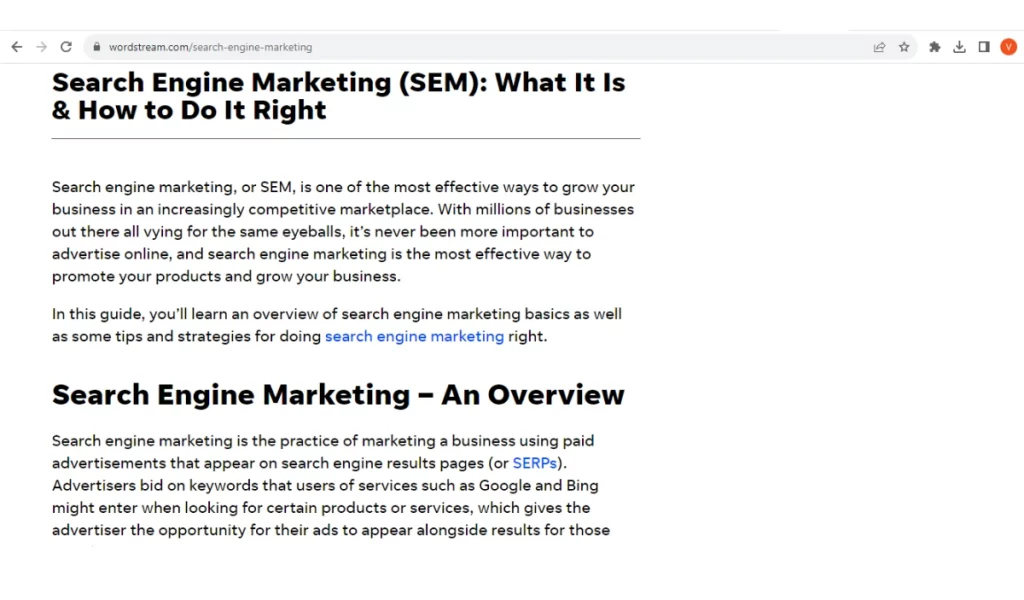
Here in the screenshot, the keywords that acquire ranking are optimized in H1 and H2 header tags in this content mentioning of keywords in Slug URL also.
However, be careful not to overdo it. Use keywords where they naturally fit in, and always ensure that your headers make sense to your readers. If you’re just stuffing in keywords, your content might not read well, and that could turn off both your audience and search engines.
So, as you draft your content, consider how you can use headers to your advantage. Not only can they help improve your SEO, but they can also make your content more engaging and easy to read.
8. Check out for backlinking opportunities
Backlinks are like gold stars in the world of SEO. They’re one of the key factors that search engines use to determine how trustworthy and valuable your website is. It’s kind of like a popularity contest – the more votes (or backlinks) you have, the higher you can climb in the rankings.
But getting these valuable backlinks isn’t just about luck. It’s about creating content that others want to link to. Content that provides valuable information, like industry-specific research or compelling statistics, tends to attract more backlinks. This is because it gives other websites a reason to reference your work.
Think of it this way: if you’re writing a paper and you come across a website that has all the data and insights you need, you’d likely reference (or link) to it. The same applies to websites. They link to your site when they find something useful, interesting, or relevant to their content.
So, as you create your content, aim to make it link-worthy. Add in those insightful stats, do that deep-dive research, and present your findings in an engaging way. Not only will this make your content more valuable to your readers, but it can also attract those golden backlinks that can boost your search engine rankings.
It takes time, effort, and a commitment to create high-quality content. But with these tips in mind, you’ll be well on your way to a successful SEO campaign.
Check Out: These link-building strategies in 2023
9. Check for technical issues from time to time on your website
Just like a well-oiled machine, your website needs to be in top shape for it to function properly. Technical issues can create roadblocks that stop Google’s bots from effectively crawling and indexing your website.
And if Google can’t properly index your site, it won’t be able to showcase it in search results. That’s like having a great book that never makes it to the library shelves – no one knows it’s there.
Regularly checking your website for these issues is like taking your car for routine maintenance. It helps ensure that Google’s crawlers can navigate your site without any hiccups, allowing your content to be indexed correctly.
And when your site is easy to crawl, Google is more likely to reward you with better visibility in search results.
So, what kind of technical issues should you be on the lookout for? It could be anything from broken links and slow loading times to problems with your website’s structure or its mobile compatibility. Using tools like Google’s Search Console can help you identify and fix these issues.
It’s also essential to have a good understanding of SEO best practices. For example, creating a sitemap makes it easier for search engines to find and index all of your site’s content. Similarly, using robots.txt files can help guide search bots toward the pages you want them to crawl and away from the ones you don’t.
10. Keep an Eye on Your Ranking Fluctuation
When you’re new to the game and starting to build your content, it’s natural to see some fluctuations in your rankings. It’s part of the journey!
However, if your keywords drop off the Search Engine Results Pages (SERPs) like a stone in water, it’s time to take a closer look. You might need to check if you’re adhering to white hat SEO techniques, which are strategies that focus on a human audience as opposed to search engines, while also obeying search engine rules and policies.
Another important aspect to consider is the intent behind your keywords. Are they truly capturing what your potential customers are searching for? If your keywords aren’t aligned with what people want, your content might not be seen as relevant or valuable.
To keep a close eye on your rank fluctuations, you could use tools like the Serpple keyword rank tracker tool to keep tracking of your potential keywords.
This tool keeps a daily check on your rankings and provides valuable insights into your highest and current rankings. It’s like having a personal coach who keeps you updated on your performance and helps you identify where there’s room for improvement.
After a certain period of time, if you still rank highly, it must be a red flag and fixing of this keyword fluctuations must be made.
One of best things you can do is to have a glance at competitor sites.
- Where are those competitors ranking?
- How are those ranking affected in terms metrics?
- What are they performing differently compared to you?
- What are the other websites which moved up in ranking?
You must provide Google time for gathering information and then have to adjust accordingly. Most website would revert to its normal position after three or four weeks.
If the website do not return to its normal position, there are certain things which could do from your side .
- Site Audit
- Content Remediation
- Usage of Internal linking to aid in leveraging your keyword targeting.
- Backlink audit.
- Get to learn and update the algorithm updates
- Backlink audit
- Keep an eye upon your Site speed.
- Focus on the Long-tail Keyword Rankings
- Counterbalance your rankings decline by Building high-quality backlinks.
What is essential is that you could stick to white-hat SEO approaches at all times.
If you perform this, you wont fall foul towards the algorithmic changes and there is a better chance you would not lose the links. Hence you are reducing the fluctuations to your rankings.
READ MORE: How To Track Your Search Engine Rankings In Google
Real Example – Time taken to rank a New SaaS Website by Google
We think to compute the time for ranking the website by Search engines, through an experimental example SEOScrum, a SaaS product of Serpple Company, launched by our team as the SEO management tool.
With focus to help teams manage their projects and enhance their internal processes by breaking down complex, overarching projects into small, frequent changes, and enabling continual progress.
Our product is now explored with the motive to integrate principles of Agile Scrum with SEO approaches, So that we can make our team more adaptable and flexible to changes in business objectives, competitive landscapes, and algorithms, in evolving digital landscape.
So now to start with, we have gathered high search volume, low search volume and keywords without any search volume and added those keywords in Homepage of SEOScrum and we kept supple without any action of backlinks and other SEO processes.
For a better understanding, I have picked out the potential keywords having high search volume ‘seo management tool’ and ‘Seo management tools’. The next one following are the keywords having low search volume ‘seo project management’ and ‘seo project management tool’.
We made Landing page to get optimized based on other keywords having zero search volume ‘seo team management tool’ and ‘seo team management’ as well.
Keyword List For our New Website – SEOScrum
| Keywords Optimzed on SEOScrum Website | Search Volume - Type | Search Volume Value |
|---|---|---|
| Seo management tool | High Search Volume | 320 |
| Seo project management | Mid Search Volume | 210 |
| Seo project management tool | 90 | |
| Seo team management tool | Zero Search Volume | 0 |
Then we deployed our new website live, on July 10. After a period of 16 days of it being launched, while checking on its analytics we spotted the behaviour of the website, wherein it was ranked by Google with those keywords. Our new website lit on to gain positive results just after 16 days. We see this ranking acquired would be because of our keywords, focussed towards search volume metric. Basically with these results, it insisted us to focus on the metric of search volume also.
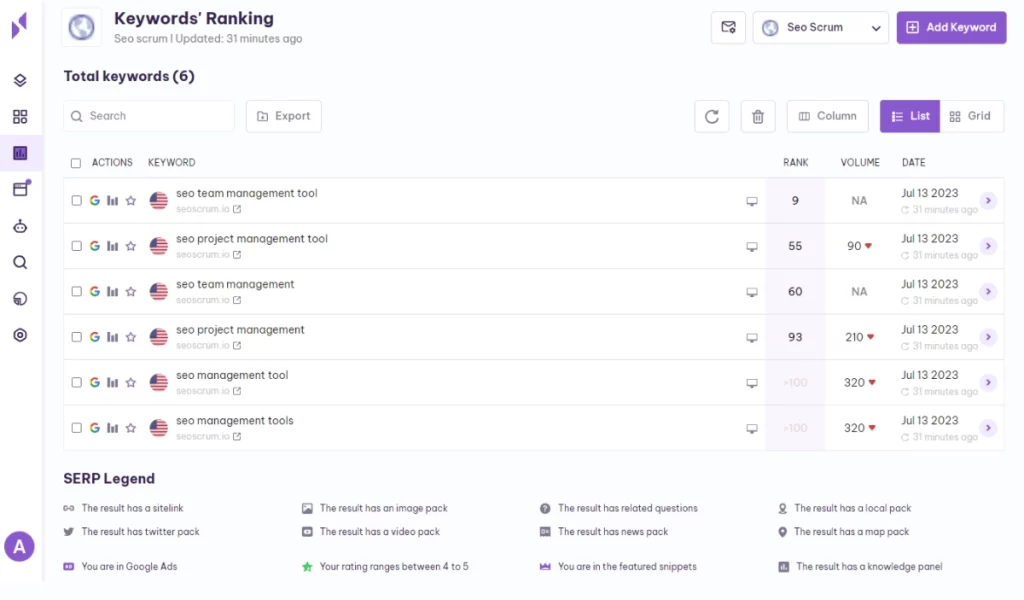
The list of keywords that we appended in SEOScrum Web Page, tracked in our tool Serpple were illustrated below. You can see the keywords having different search volume below and the initiative we did on July 13th .
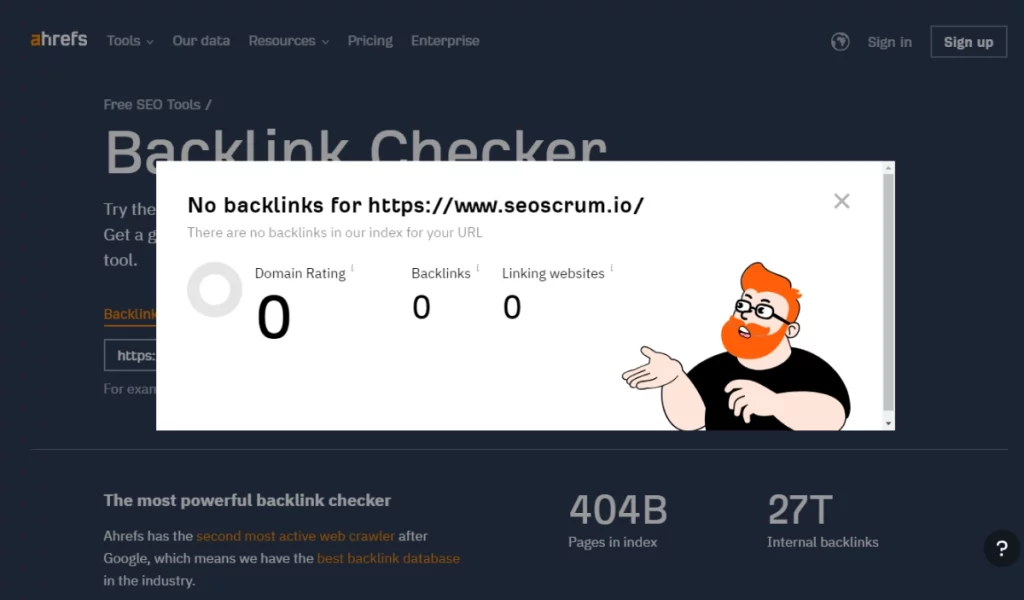
The above data in the backlink checker of ahrefs exposes that there are no backlinks and other SEO activities posed on our tested website.
The impressions and click rate are gained at the time when the website is launched, while the keywords are added on July 13th.
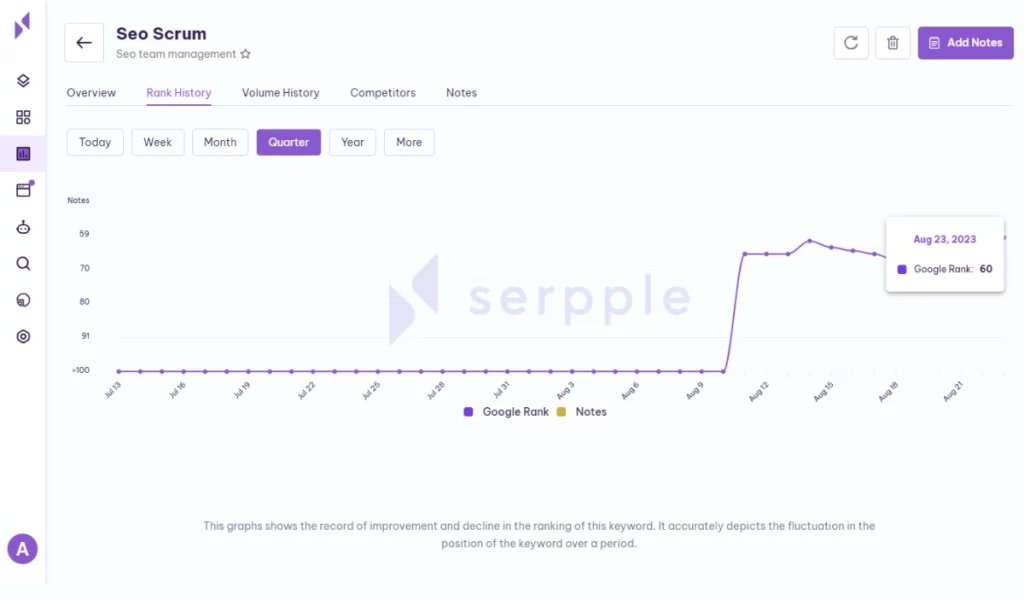
The keyword ‘Seo team management’ which is without Search volume also got ranked in google. While tracking the keywords after 40 days, outcomes are shown with rankings in Google.
Also, the results imply us about the keywords without any search volume as shown above , the keyword ‘Seo team management’ highlighted yields better ranking in Google. Hence the implication found is while creating a new website, you can go forward in targeting keywords on your web pages based on the search volume factor as we have showcased the results of SEOScrum website as a live example.
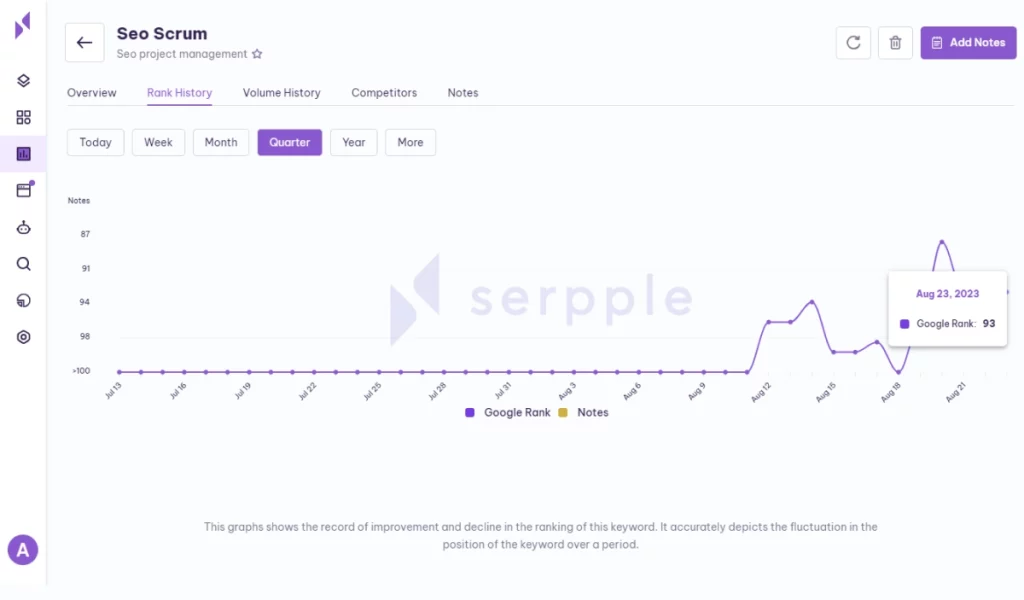
Similarly, In the above representation, the rankings in Google are depicted for the keyword ‘SEO project management’.
Being this as an experimental setup to analyse how much time does it take to rank on google, the keywords with high, low and Zero search volume are projected as per primary plan and it successfully went on to get ranking in Google.
Hence the response for the query How long does it take to rank a new website depended on our keywords concentrated with search volume metric now from our inference got by this example.
Conclusion
To wrap it up, ranking a website on Google isn’t a sprint – it’s a marathon that requires time, effort, and strategic planning. While the time it takes to rank can vary significantly, it’s critical to stay patient and persistent.
Keep in mind, the journey of SEO isn’t just about getting to the top of the SERPs. It’s about creating valuable, engaging content that answers your audience’s questions and meets their needs.
It’s about ensuring your website is technically sound, and free from issues that might block search engine bots from crawling and indexing your site. It’s about selecting the right keywords that reflect your audience’s intent, and strategically placing them in your content.
Moreover, it’s essential to monitor your site’s performance, paying attention to rank fluctuations and adapting your strategies as needed. Tools like the Serpple Google rank tracker can be invaluable in helping you stay informed and make data-driven decisions.
Hence along with this detailed information, the metrics in which Google does ranking are also explicated through experimental examples as well in a SaaS product.
Ultimately, while the SEO journey may take some time, the rewards – increased visibility, more organic traffic accomplished with knowing the importance of Digital Marketing for small businesses, and a stronger online presence are worth the effort. Stay consistent, keep learning, and remember that every step you take brings you closer to your goal and increases brand visibility to cover a wide audience.
Published by
Adam White
Adam White is a 20+ year SEO professional who has optimized over 400 websites, built and sold over 20 internet and SaaS businesses all with SEO as the main traffic source. Follow him on Twitter/X
All stories by Adam White


